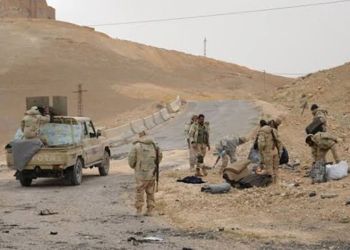This post is also available in:
![]() العربية
العربية
After the declaration of Baghdadi’s pseudo-caliphate, Daesh began calling on people to migrate to areas that had been taken by Daesh’s gangs, after the withdrawal of the Iraqi forces from three major cities. Daesh members were deluded, believing their group had acquired the characteristics of a state. Their delusions increased because the Iraqi forces abandoned their weapons and ammunition – enough for four to five years.
We do not want to sound like conspiracy theorists, but we wonder: would it not have been better to send even one armed faction towards Mosul? Or send one aircraft to bomb the weapons and car warehouses? Let’s admit that the big game that Iran and its allies in the region have created has been successful in turning Sunni areas in Iraq and Syria into a conflict zone that has burned everything to the ground. More than 80,000 foreign fighters were recruited between 2013 and 2016 to fight in Daesh ranks, most of whom came from Tunisia, Libya, Saudi Arabia, Egypt, Germany, France, the Caucasus, China and Canada.

85% of Daesh fighters are foreigners, and despite the operation that began in mid-2016 to uproot the organization in Iraq and Syria, more than 20,000 foreign mercenaries are still fighting with Daesh to date. In other words, the organization lost nearly 60,000 fighters due to repeated military operations, reckless decisions, and desperate attempts at steadfastness.
After the killing of very senior leaders, such as Adnani and others, Daesh replaced most of the field commanders with weak, local ones. In addition, most of the foreign members defected to join anti-Daesh HaD (Hurrass Al-Deen) Group which is affiliated with Al-Qaeda. Many other foreign members have been arrested by the Kurds, the most important ally for the International Coalition.

All of this plays a huge role in paralyzing Daesh which is trying to recycle its deteriorating image claiming that its defeats are victories, all with the help of Daesh media institutions and false propaganda. Daesh Al-Naba’ newspaper and Telegram channels, such as the Al-Muhajireen Foundation, try to polish the image of Daesh claiming that it is triumphant. This is to give a military and a religious boost to fighters. Pro-Daesh institutions such as Al-Saqri, Al-Battar and Al-Abd Al-Faqir also publish videos urging fighters to conduct operations in their countries.

If we look closely, and objectively, into the history of Daesh, we may come across many questions that Daesh is trying not to answer. The biggest question is related to those foreign fighters. What is the fate of those of them who are left, and what is this ever-weakening Daesh planning to do next?
Written by: Omar Abu Layla
Deir Ezzour 24 Network, Executive Manager












